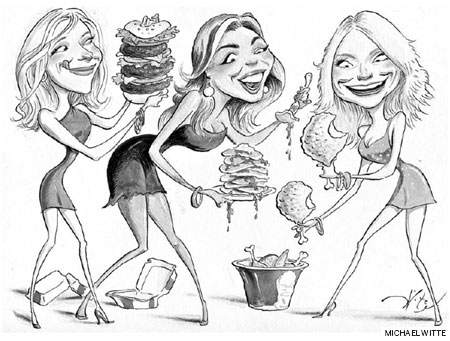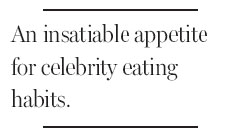Movie
Sometimes, even starlets eat like real human beings
Updated: 2011-03-13 07:57
By Jeff Gordinier (New York Times)

 |
Jennifer Lawrence, an Oscar nominee for her leading role in "Winter's Bone," wants it known that a skimpy morning repast is not going to satisfy her.
"I'm freakish about breakfast," she explains to an Esquire magazine writer there to interview her. "You're not gonna order, like, fruit or something, are you? Because I'm gonna eat." We then learn that Ms. Lawrence "orders the eggs Benedict without looking at the menu."
For regular readers of glossy magazines - which depend on interviews with famous people to generate chatter and increase newsstand sales - such situations have become increasingly familiar. A writer meets a starlet for breakfast, lunch or dinner. The slim starlet thwarts our expectations by ordering and consuming, with conspicuous relish, a meal that might satisfy a hungry dockworker.
Such passages are widespread enough in the pages of American periodicals that one longtime film publicist, Jeremy Walker, has coined a term of art for them: the documented instance of public eating, or DIPE. Consider, for example, Cate Blanchett impulse-ordering a side of Parmesan-fried zucchini at a restaurant in London and impishly telling a writer from Vogue that she doesn't intend to share: "I think we'd each better get our own, or things could get ugly."
Even when an actress doesn't overtly chow down, it is not unusual for her to gush about her fondness for doing so. "I actually really love to lie in bed, watch TV, be a total sloth, and eat my favorite food: Kraft macaroni and cheese," Drew Barrymore told Harper's Bazaar in the October 2010 issue. Cameron Diaz, it seems, cannot resist a burger and fries. Gearing up to play Etta James in "Cadillac Records," Beyoncé Knowles relied on butter pecan ice cream.
From a practical standpoint, this fixation on celebrity nourishment is surely a byproduct of restricted access. Publicists, wary of prying questions, have become skilled at compressing conversations with reporters to a bare minimum. "In the old days you wouldn't just spend an hour with someone," said Kevin Sessums, a writer for publications like Vanity Fair. "In the old days you'd spend three or four days with someone."
Given such paltry resources, journalists who write about celebrities probably can't be blamed for succumbing to an amateur lesson in gastronomic semiotics - one in which each bite is supposed to yield insight.
Mr. Sessums, though, sees the restaurant rendezvous as a kind of Hollywood filibuster. "I prefer to have their mouths free for conversation," he said.
"If she puts mayonnaise and mustard on a hamburger instead of relish and pickle, that doesn't tell me a thing about the person I'm trying to talk to."
Or does it? In a news media arena where an actress like Keira Knightley is taken to task for her bony angularity while Christina Hendricks of the "Mad Men" television series is fetishized for her throwback curves, it is clear that the topic of how beautiful women eat has become something of a chronic national obsession.
Any individual DIPE may not shed much light on the inner life of the latest actress, but collectively, their frequency seems to tell us something about societal standards, judgments and yearnings.
"Don't you feel awfully sorry for actresses?" said Bumble Ward, who spent years as a Hollywood publicist before leaving to write a blog and work on a novel. "They're so sure that people assume they have an eating disorder that they're forced to wolf down caveman-like portions of ‘comfort food' in order to appear normal."
Maybe it shouldn't come as a shock that the DIPE seems to appear with the greatest regularity in men's magazines. "It's just a male fantasy," says Padma Lakshmi, the model, "Top Chef" television show host and cookbook author, a fantasy in which one manifestation of finger-licking desire serves as a symbolic surrogate for another.
That actresses are reportedly human. That they depend on food for survival should come as no surprise. Nevertheless, putting a spotlight on what they eat for lunch during an interview seems to arouse a fair amount of skepticism.
"I don't actually think that actresses eat - I really don't," said Sara Jenkins, who runs two restaurants in Manhattan, Porchetta and Porsena. "When I see them chowing down on fried chicken and hamburgers, I guess it is code for ‘she's just a normal person.' But why do they have to be down-home, ordinary people? They're not, you know?"
For a cultural observer like Carol J. Adams - a vegan-feminist intellectual who, in books like "The Sexual Politics of Meat," has devoted much of her life to culling and analyzing images of women and food - the DIPE amounts to more than a playful wink. Sexualizing food, she argues, is a method of distracting carnivores from the gruesome reality of how their food is made.
"These images of women, whether they're ads or they're in magazines, they're all saying the same thing: traditional consumption of women's bodies and animals' bodies is O.K.," Ms. Adams said.
Anna Holmes, a founding editor of Jezebel, a culture-deconstructing Web site that singles out women, is skeptical of such moments of documented feasting. "I'm usually pretty cynical about it," she said.
"When the writer has made special mention of what the actress is eating, especially if it's something incredibly high-calorie or fattening, I do roll my eyes," she said, "because I assume that it's planted."
The New York Times
Specials

Tea-ing up
More turning to Chinese tea for investment opportunities like vintage wine

A cut above
The ancient city of Luoyang is home to a treasure trove of cultural wonders.

Rise and shine
The Chinese solar energy industry is heating up following recent setbacks in the nuclear sector